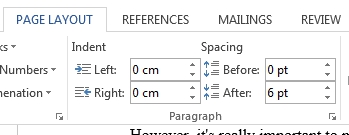- 3-minute read
- 28th May 2015
7 Tips on Formatting Your Work
Let’s be honest, formatting your work can be a pain. One of the biggest problems is where to start, since Microsoft Word offers so many options.
However, we’ve compiled some great tips to make formatting simple. Why not try them in your next essay?
1. Get Over Your Fear of Styles
‘Styles’ allow you to modify the style of text you use in a document, providing a quick way of formatting headings and captions in your work. They also make it easier to ensure the formatting in your document is consistent throughout.
Furthermore, once you have added ‘Heading’ styles to your document, you can even use them to generate a table of contents. Here’s how.
2. Give Yourself Space
Have you been typing carriage returns between paragraphs? You don’t need to! It’s much easier to adjust the paragraph spacing!
To do this, go to the ‘Page Layout’ tab in MS Word and adjust the ‘Spacing’ in the ‘Paragraph’ menu. An automatic gap will then appear either before or after a paragraph every time you hit return!
3. Justify This!
The alignment of your text determines how it is spread on the page. Most essays look neatest when you use the ‘Justified’ alignment, which aligns your text so that it meets both left and right margins on the page. This looks tidy and can make your work easier to read.
Find this useful?
Subscribe to our newsletter and get writing tips from our editors straight to your inbox.
Subscribe to Beyond the Margins and get your monthly fix of editorial strategy, workflow tips, and real-world examples from content leaders.
To do this, simply select the text you want to modify and click the ‘Justify’ button in the ‘Paragraph’ options on the ‘Home’ tab (or use ‘Ctrl + J’). If you are using ‘Styles’, you can also modify the ‘Normal’ template to justify text to which this style has been applied.
4. Be Marginal
Generally, a 4cm margin on the left of the page and a 2.5cm margin on the right will be suitable for an academic essay. This may differ from institution to institution, though, so make sure to check your style guide.
5. Space (Your Lines) Out
Single spaced text can be hard to read. Most academic essays are 1.5 or even double-spaced, so adjusting line spacing is a good idea. Check your university guidelines on this.
6. Your Number Is Up!
Numbering your pages is essential, but factors to consider include:
- Page numbering should usually begin after your cover page
- Dissertations and longer documents may use Roman numerals on preliminary pages (e.g. your table of contents, abstract page, acknowledgements, etc.)
- Arabic numerals should be used from the introduction onwards
7. Give Me a (Page) Break!
Splitting a long document, like a dissertation, into distinct chapters will make it easier to read. However, each new chapter should begin on a new page.
If you use carriage returns to do this, the text will shift all over the place when you edit anything before the page break. Using MS Word’s page breaks prevents this.
Hopefully these tips have helped. But if you are still stuck, give us a shout and we’ll show you what we can do!





